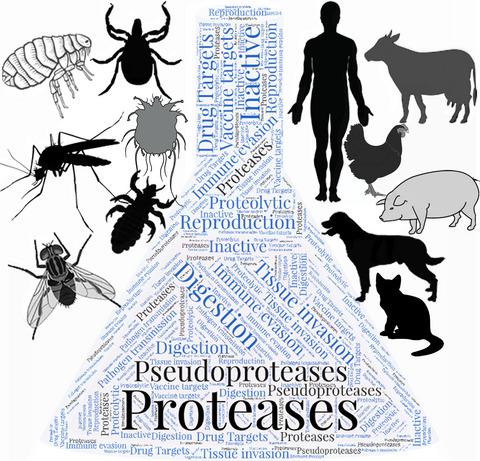Our official English website, www.x-mol.net, welcomes your feedback! (Note: you will need to create a separate account there.)
Proteases and pseudoproteases in parasitic arthropods of clinical importance.
The FEBS Journal ( IF 5.4 ) Pub Date : 2020-09-06 , DOI: 10.1111/febs.15546 Deepani Darshika Fernando 1 , Katja Fischer 1
The FEBS Journal ( IF 5.4 ) Pub Date : 2020-09-06 , DOI: 10.1111/febs.15546 Deepani Darshika Fernando 1 , Katja Fischer 1
Affiliation

|
Parasitic arthropods feed on blood or skin tissue and share comparable repertoires of proteases involved in haematophagy, digestion, egg development and immunity. While proteolytically active proteases of multiple classes dominate, an increasing number of pseudoproteases have been discovered that have no proteolytic function but are pharmacologically active biomolecules, evolved to carry out alternative functions as regulatory, antihaemostatic, anti‐inflammatory or immunomodulatory compounds. In this review, we provide an overview of proteases and pseudoproteases from clinically important arthropod parasites. Many of these act in central biological pathways of parasite survival and host–parasite interaction and may be potential targets for therapeutic interventions.
中文翻译:

具有重要临床意义的寄生节肢动物中的蛋白酶和假蛋白酶。
寄生节肢动物以血液或皮肤组织为食,并共享与血细胞吞噬,消化,卵子发育和免疫有关的类似蛋白酶。尽管多类蛋白水解活性蛋白酶占主导地位,但已发现越来越多的伪蛋白酶不具有蛋白水解功能,而是具有药理活性的生物分子,逐渐演变为具有替代功能,例如调节,止血,抗炎或免疫调节化合物。在这篇综述中,我们提供了具有临床重要性的节肢动物寄生虫的蛋白酶和假蛋白酶的概述。这些中的许多在寄生虫存活和宿主-寄生虫相互作用的中央生物学途径中起作用,并且可能是治疗干预的潜在靶标。
更新日期:2020-10-07
中文翻译:

具有重要临床意义的寄生节肢动物中的蛋白酶和假蛋白酶。
寄生节肢动物以血液或皮肤组织为食,并共享与血细胞吞噬,消化,卵子发育和免疫有关的类似蛋白酶。尽管多类蛋白水解活性蛋白酶占主导地位,但已发现越来越多的伪蛋白酶不具有蛋白水解功能,而是具有药理活性的生物分子,逐渐演变为具有替代功能,例如调节,止血,抗炎或免疫调节化合物。在这篇综述中,我们提供了具有临床重要性的节肢动物寄生虫的蛋白酶和假蛋白酶的概述。这些中的许多在寄生虫存活和宿主-寄生虫相互作用的中央生物学途径中起作用,并且可能是治疗干预的潜在靶标。



























 京公网安备 11010802027423号
京公网安备 11010802027423号